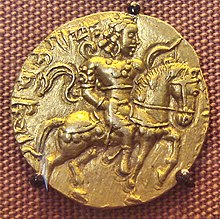| Amrakarddava | |
|---|---|
| Minister of the Gupta Empire | |
| Reign | c. 4th–5th century CE |
| Born | Sukuli-desa, Madhya Pradesh |
| Dynasty | Karddava (possibly Naga lineage) |
| Religion | Buddhism |
| Military career | |
| Battles / wars | Gupta–Saka Wars |
Amrakarddava was a general from Sukuli-desa (present day Madhya Pradesh) in the service of Emperor Chandragupta II of the Gupta Empire. He was known for his military skill and fought and won many of the major battles, including campaigns over the Saka war.
Etymology
Etymological significance of the Name "Amrakarddava" The first part possibly referring to mango tree, "Amra" is his name of becoming personal. The second part, "Karddava," comes from "Kadru," the mythological Indian mother of serpents. By way of metathesis, "Kadrava" becomes "Karddava," "born of Kadru." This indicates a relationship with the Nagas, serpent-demons who inhabit the netherworld.
Another obvious indicator of this interpretation is matriarchal names, which are often utilized in aboriginal communities and lower castes in southern India. Hence, "Amrakarddava" is an intertext that is best grasped.
Military achievements
Main article: Gupta–Saka WarsAmrakarddava's military career is emphasized in inscriptions that speak of him as having won "banners of victory and fame in many battles." This warrior, who became one of his important & notable achievements where he participated in the Gupta–Saka Wars along with Emperor Chandragupta II.

An inscription from one of the caves at Udayagiri Hill, about two miles northwest of Bhilsa, notes the dedication of a cave to Sambhu by a minister named Virasena who was in the service of Chandragupta II. This undecorated inscription is believed to refer to the Saka war.
A second inscription, dated to Gupta Year 93 (the date gives the Gregorian equivalent of 412–413 CE), records donations made by Amrakarddava to a major Buddhist Vihara on the site. Historians have connected this note to the Saka war, and they have argued that this conflict lasted for a long time.
Patronage of Buddhism
In addition to his military exploits, Amrakarddava is known for supporting Buddhist monasteries. Moreover, they also express his financial backing of temple sites and religious bodies of that period. A donative inscription reveals that Amrakarddava, contributed a village and 25 dinars to ensure the perpetual maintenance of ten Buddhist monks and two lamps within the monastery at Sanchi.
Legacy

Amrakarddava remains a significant figure in Gupta history, symbolizing both military excellence and cultural patronage. His role in the Saka war and his contributions to Buddhism highlight his multifaceted contributions to the Gupta Empire.
See also
References
- ^ Sharma, Tej Ram (1978). Personal and Geographical Names in the Gupta Inscriptions. Concept Publishing Company. p. 47.
- S. R. Goyal (1967). A history of the Imperial Guptas. With a Foreword by R. C. Majumdar. p. 247.
- * 1910,0403.26
- ^ S. R. Goyal (1967). A history of the Imperial Guptas. With a Foreword by R. C. Majumdar. p. 248.
- ^ Cotterell, Arthur (1998). The Pimlico Dictionary of Classical Civilizations: Greece, Rome, Persia, India and China. Pimlico. p. 77. ISBN 978-0-7126-7496-6.
- Ingalls, Daniel H. H. (1976). "Kālidāsa and the Attitudes of the Golden Age". Journal of the American Oriental Society. 96 (1): 15–26. doi:10.2307/599886. ISSN 0003-0279. JSTOR 599886.